Estimation of Time-Series Forest Leaf Area Index (LAI) Based on Sentinel-2 and MODIS
Abstract
:1. Introduction
| LAI Product | Sensor | Spatial Resolution | Temporal Resolution | Span | References |
|---|---|---|---|---|---|
| MOD15 | TERRA-AQUA | 1 km | 8 days | Since 2000 | Knyazikhin et al. [42] |
| GIMMS3g | AVHRR | 8 km | 15 days | 1981–2011 | Zhu et al. [43] |
| GEOV1 | SPOT | 1 km | 10 days | Since 1998 | Baret et al. [44] |
| GLASS | MODIS | 0.5 km | 4 days | Since 1981 | Xiao et al. [29] |
2. Materials and Methods
2.1. Study Area
2.2. Data and Preprocessing
2.2.1. Remote Sensing Data and Pre-Processing
2.2.2. LAI Field Measurements
2.2.3. Forest Type Data
2.3. Methods
2.3.1. Construction of Remote Sensing Model for LAI
2.3.2. Normalized LAI Growth Function and Daily LAI Calculation
3. Results
3.1. Remote Sensing Model of LAI in Saihanba Area
3.1.1. Univariate Regression Analysis
3.1.2. Multiple Linear Regression Analysis
3.1.3. PCA Model
3.2. MODIS LAI Normalized Growth Curve Extraction
3.3. Daily LAI Calculation of Small and Medium-Sized Regional Scale
4. Discussion
5. Conclusions
Author Contributions
Funding
Institutional Review Board Statement
Informed Consent Statement
Data Availability Statement
Acknowledgments
Conflicts of Interest
References
- Mao, Y.; Michel, O.; Yu, Y.; Fan, W.; Sui, A.; Liu, Z.; Wu, G. Retrieval of Boreal Forest Heights Using an Improved Random Volume over Ground (RVoG) Model Based on Repeat-Pass Spaceborne Polarimetric SAR Interferometry: The Case Study of Saihanba, China. Remote Sens. 2021, 13, 4306. [Google Scholar] [CrossRef]
- Owe, M.; Tian, Q.; D’Urso, G.; Chen, J.M.; Zheng, G.; Neale, C.M.U.; Gouweleeuw, B.T.; Xia, X.; Chen, J. Quantitative retrieving forest ecological parameters based on remote sensing in Liping County of China. Remote Sens. Agric. Ecosyst. Hydrol. VIII 2006, 6539, 317–326. [Google Scholar] [CrossRef]
- Hall, F.G.; Bergen, K.; Blair, J.B.; Dubayah, R.; Houghton, R.; Hurtt, G.; Kellndorfer, J.; Lefsky, M.; Ranson, J.; Saatchi, S.; et al. Characterizing 3D vegetation structure from space: Mission requirements. Remote Sens. Environ. 2011, 115, 2753–2775. [Google Scholar] [CrossRef] [Green Version]
- Yang, L.; Robert, T.; Fabio, G. Automated estimation of forest height and underlying topography over a Brazilian tropical forest with single-baseline single-polarization TanDEM-X SAR interferometry. Remote Sens. Environ. 2021, 252, 112132. [Google Scholar] [CrossRef]
- Houghton, R.A.; Hall, F.; Goetz, S.J. Importance of biomass in the global carbon cycle. J. Geophys. Res. Biogeosci. 2009, 114, G00E03. [Google Scholar] [CrossRef]
- Myneni, R.B.; Hoffman, S.; Knyazikhin, Y.; Privette, J.L.; Glassy, J. Global products of vegetation leaf area and fraction absorbed par from year one of modis data. Remote Sens. Environ. 2002, 83, 214–231. [Google Scholar] [CrossRef] [Green Version]
- Gao, W.; Walthall, C.L.; Shaw, D.R.; Dulaney, W.P.; Anderson, M.C.; Norman, J.; Fang, H.; Liang, S.; Timlin, D.J.; Pachepsky, Y. Alternative approaches for estimating leaf area index (LAI) from remotely sensed satellite and aircraft imagery. Remote Sens. Model. Ecosyst. Sustain. 2004, 5544, 241–255. [Google Scholar] [CrossRef]
- Arora, V. Modeling Vegetation as a Dynamic Component in Soil-Vegetation-Atmosphere Transfer Schemes and Hydrological Models. Rev. Geophys. 2002, 40, 3-1–3-26. [Google Scholar] [CrossRef] [Green Version]
- Sellers, P.J. Modeling the Exchanges of Energy, Water, and Carbon Between Continents and the Atmosphere. Science 1997, 275, 502–509. [Google Scholar] [CrossRef] [Green Version]
- Ge, J. On the Proper Use of Satellite-Derived Leaf Area Index in Climate Modeling. J. Clim. 2009, 22, 4427–4433. [Google Scholar] [CrossRef]
- Luo, S.; Wang, C.; Zhang, G.; Xi, X.; Li, G. Forest Leaf Area Index (LAI) Estimation Using Airborne Discrete-Return Lidar Data. Chin. J. Geophys. 2013, 56, 233–242. [Google Scholar] [CrossRef]
- Sellers, P.J.; Mintz, Y.; Sud, Y.C.; Dalcher, A. A Simple Biosphere Model (SIB) for Use within General Circulation Models. J. Atmos. Sci. 1986, 43, 505–531. [Google Scholar] [CrossRef]
- Xu, J.; Quackenbush, L.J.; Volk, T.A.; Im, J. Forest and Crop Leaf Area Index Estimation Using Remote Sensing: Research Trends and Future Directions. Remote Sens. 2020, 12, 2934. [Google Scholar] [CrossRef]
- Muhammad, A.; Carsten, M.; Anja, S.; Gunter, M.; Frank, T.; Harry, V. Estimation and Validation of RapidEye-Based Time-Series of Leaf Area Index for Winter Wheat in the Rur Catchment (Germany). Remote Sens. 2015, 7, 2808–2831. [Google Scholar] [CrossRef] [Green Version]
- Quan, X.; He, B.; Wang, Y.; Tang, Z.; Li, X. An Extended Fourier Approach to Improve the Retrieved Leaf Area Index (LAI) in a Time Series from an Alpine Wetland. Remote Sens. 2014, 6, 1171–1190. [Google Scholar] [CrossRef] [Green Version]
- Myneni, R.B.; Ramakrishna, R.; Nemani, R.; Running, S.W. Estimation of global leaf area index and absorbed par using radiative transfer models. IEEE Trans. Geosci. Remote Sens. 1997, 35, 1380–1393. [Google Scholar] [CrossRef] [Green Version]
- Houborg, R.; Anderson, M.C. Utility of an image-based canopy reflectance modeling tool for remote estimation of LAI and leaf chlorophyll content at regional scales. J. Appl. Remote Sens. 2009, 3, 033529. [Google Scholar] [CrossRef]
- Chen, J.; Pavlic, G.; Brown, L.; Cihlar, J.; Leblanc, S.G. Derivation and validation of canada-wide coarse-resolution leaf area index maps using high-resolution satellite imagery and ground measurements. Remote Sens. Environ. 2002, 80, 165–184. [Google Scholar] [CrossRef]
- Jacquemoud, S.; Verhoef, W.; Baret, F.; Bacour, C.; Zarco-Tejada, P.J.; Asner, G.P.; François, C.; Ustin, S.L. PROSPECT+SAIL models: A review of use for vegetation characterization. Remote Sens. Environ. 2009, 113, S56–S66. [Google Scholar] [CrossRef]
- Haboudane, D. Hyperspectral vegetation indices and novel algorithms for predicting green LAI of crop canopies: Modeling and validation in the context of precision agriculture. Remote Sens. Environ. 2004, 90, 337–352. [Google Scholar] [CrossRef]
- Cohen, W.B.; Maiersperger, T.K.; Gower, S.T.; Turner, D.P. An improved strategy for regression of biophysical variables and Landsat ETM+ data. Remote Sens. Environ. 2003, 84, 561–571. [Google Scholar] [CrossRef] [Green Version]
- Colombo, R. Retrieval of leaf area index in different vegetation types using high resolution satellite data. Remote Sens. Environ. 2003, 86, 120–131. [Google Scholar] [CrossRef]
- Yotov, K.; Li, X.; Ren, G.; Cibulskis, M.; Dejong, G.; Garzaran, M. A comparison of empirical and model-driven optimization. ACM SIGPLAN Not. 2003, 38, 63–76. [Google Scholar] [CrossRef] [Green Version]
- Feng, D.; Chen, J.M.; Plummer, S.; Chen, M.; Pisek, J. Algorithm for global leaf area index retrieval using satellite imagery. IEEE Trans. Geosci. Remote Sens. 2006, 44, 2219–2229. [Google Scholar] [CrossRef] [Green Version]
- Wiegand, C.L.; Maas, S.J.; Aase, J.K.; Hatfield, J.L.; Pinter, P.J.; Jackson, R.D. Multisite analyses of spectral-biophysical data for wheat. Remote Sens. Environ. 1992, 42, 1–21. [Google Scholar] [CrossRef]
- Stagakis, S.; Markos, N.; Sykioti, O.; Kyparissis, A. Monitoring canopy biophysical and biochemical parameters in ecosystem scale using satellite hyperspectral imagery: An application on a Phlomis fruticosa Mediterranean ecosystem using multiangular CHRIS/PROBA observations. Remote Sens. Environ. 2010, 114, 977–994. [Google Scholar] [CrossRef]
- Liu, J.; Pattey, E.; Jégo, G. Assessment of vegetation indices for regional crop green LAI estimation from Landsat images over multiple growing seasons. Remote Sens. Environ. 2012, 123, 347–358. [Google Scholar] [CrossRef]
- Curran, P.J.; Steven, M. Multispectral Remote Sensing for the Estimation of Green Leaf Area Index [and Discussion]. Philos. Trans. R. Soc. A Math. Phys. Eng. Sci. 1983, 309, 257–270. [Google Scholar]
- Xiao, Z.; Liang, S.; Wang, J.; Xiang, Y.; Zhao, X.; Song, J. Long-Time-Series Global Land Surface Satellite Leaf Area Index Product Derived From MODIS and AVHRR Surface Reflectance. IEEE Trans. Geosci. Remote Sens. 2016, 54, 1–18. [Google Scholar] [CrossRef]
- Fang, H.; Baret, F.; Plummer, S.; Schaepman-Strub, G. An Overview of Global Leaf Area Index (LAI): Methods, Products, Validation, and Applications. Rev. Geophys. 2019, 57, 739–799. [Google Scholar] [CrossRef]
- Chen, J.; Jönsson, P.; Tamura, M.; Gu, Z.; Matsushita, B.; Eklundh, L. A simple method for reconstructing a high-quality NDVI time-series data set based on the Savitzky–Golay filter. Remote Sens. Environ. 2004, 91, 332–344. [Google Scholar] [CrossRef]
- Xiao, Z.; Liang, S.; Wang, J.; Song, J.; Wu, X. A Temporally Integrated Inversion Method for Estimating Leaf Area Index From MODIS Data. IEEE Trans. Geosci. Remote Sens. 2009, 47, 2536–2545. [Google Scholar] [CrossRef]
- Xie, Y.; Wang, P.; Bai, X.; Khan, J.; Zhang, S.; Li, L.; Wang, L. Assimilation of the leaf area index and vegetation temperature condition index for winter wheat yield estimation using Landsat imagery and the CERES-Wheat model. Agric. For. Meteorol. 2017, 246, 194–206. [Google Scholar] [CrossRef]
- Chen, Y.; Li, D.; Han, Q.; Zhang, X.; Zhang, Q. Time series assessment of multi-source spatiotemporal fusion reconstruction data based on dynamic time warping. In Proceedings of the IEEE International Conference on Artificial Intelligence and Computer Applications (ICAICA), Dalian, China, 27–29 June 2020; pp. 858–864. [Google Scholar] [CrossRef]
- Xiao, Z.; Liang, S.; Wang, J.; Wang, Z. Retrieval of Leaf Area Index by Coupling Radiative Transfer Model and a Dynamic Model. In Proceedings of the IEEE International Geoscience and Remote Sensing Symposium, Boston, MA, USA, 6–11 July 2008; pp. v554–v557. [Google Scholar] [CrossRef]
- Verger, A.; Filella, I.; Baret, F.; Peñuelas, J. Vegetation baseline phenology from kilometric global LAI satellite products. Remote Sens. Environ. 2016, 178, 1–14. [Google Scholar] [CrossRef] [Green Version]
- Xun, L.; Wang, P.; Li, L.; Wang, L.; Kong, Q. Identifying crop planting areas using Fourier-transformed feature of time series MODIS leaf area index and sparse-representation-based classification in the North China Plain. Int. J. Remote Sens. 2018, 40, 2034–2052. [Google Scholar] [CrossRef]
- Feng, G.; Martha, C.A.; William, P.K.; Wang, Y.J. Simple method for retrieving leaf area index from Landsat using MODIS leaf area index products as reference. J. Appl. Remote Sens. 2012, 6, 063554. [Google Scholar] [CrossRef]
- Propastin, P.; Panferov, O. Retrieval of remotely sensed LAI using Landsat ETM+ data and ground measurements of solar radiation and vegetation structure: Implication of leaf inclination angle. Int. J. Appl. Earth Obs. Geoinf. 2013, 25, 38–46. [Google Scholar] [CrossRef]
- Turner, D.P.; Cohen, W.B.; Kennedy, R.E.; Fassnacht, K.S.; Briggs, J.M. Relationships between Leaf Area Index and Landsat TM Spectral Vegetation Indices across Three Temperate Zone Sites. Remote Sens. Environ. 1999, 70, 52–68. [Google Scholar] [CrossRef]
- Schlerf, M.; Atzberger, C. Inversion of a forest reflectance model to estimate structural canopy variables from hyperspectral remote sensing data. Remote Sens. Environ. 2006, 100, 281–294. [Google Scholar] [CrossRef]
- Knyazikhin, Y.; Martonchik, J.V.; Myneni, R.B.; Diner, D.J.; Running, S.W. Synergistic algorithm for estimating vegetation canopy leaf area index and fraction of absorbed photosynthetically active radiation from MODIS and MISR data. J. Geophys. Res. Atmos. 1998, 103, 32257–32275. [Google Scholar] [CrossRef] [Green Version]
- Zhu, Z.; Bi, J.; Pan, Y.; Ganguly, S.; Anav, A.; Xu, L.; Samanta, A.; Piao, S.; Nemani, R.; Myneni, R. Global Data Sets of Vegetation Leaf Area Index (LAI)3g and Fraction of Photosynthetically Active Radiation (FPAR)3g Derived from Global Inventory Modeling and Mapping Studies (GIMMS) Normalized Difference Vegetation Index (NDVI3g) for the Period 1981 to 2011. Remote Sens. 2013, 5, 927–948. [Google Scholar] [CrossRef] [Green Version]
- Baret, F.; Weiss, M.; Lacaze, R.; Camacho, F.; Makhmara, H.; Pacholcyzk, P.; Smets, B. GEOV1: LAI and FAPAR essential climate variables and FCOVER global time series capitalizing over existing products. Part1: Principles of development and production. Remote Sens. Environ. 2013, 137, 299–309. [Google Scholar] [CrossRef]
- Zhang, W.; Li, A.; Jin, H.; Bian, J.; Zhang, Z.; Lei, G.; Qin, Z.; Huang, C. An Enhanced Spatial and Temporal Data Fusion Model for Fusing Landsat and MODIS Surface Reflectance to Generate High Temporal Landsat-Like Data. Remote Sens. 2013, 5, 5346–5368. [Google Scholar] [CrossRef] [Green Version]
- Hilker, T.; Wulder, M.A.; Coops, N.C.; Linke, J.; McDermid, G.; Masek, J.G.; Gao, F.; White, J.C. A new data fusion model for high spatial- and temporal-resolution mapping of forest disturbance based on Landsat and MODIS. Remote Sens. Environ. 2009, 113, 1613–1627. [Google Scholar] [CrossRef]
- Lu, W.; Fan, W. Fast estimation method for time-series forest LAI at small and medium regional scale. Trans. Chin. Soc. Agric. Eng. (Trans. CSAE) 2016, 32, 188–193. [Google Scholar] [CrossRef]
- Zhu, X.; Cai, F.; Tian, J.; Williams, T. Spatiotemporal Fusion of Multisource Remote Sensing Data: Literature Survey, Taxonomy, Principles, Applications, and Future Directions. Remote Sens. 2018, 10, 527. [Google Scholar] [CrossRef] [Green Version]
- Cai, Z.; Junttila, S.; Holst, J.; Jin, H.; Ard, J.; Ibrom, A.; Peichl, M.; Mölder, M.; Jönsson, P.; Rinne, J.; et al. Modelling Daily Gross Primary Productivity with Sentinel-2 Data in the Nordic Region–Comparison with Data from MODIS. Remote Sens. 2021, 13, 469. [Google Scholar] [CrossRef]
- Georgia, D.; Zina, M.; Ferran, G.; Philippe, G.; Bojan, B. A Spectral Unmixing Model for the Integration of Multi-Sensor Imagery: A Tool to Generate Consistent Time Series Data. Remote Sens. 2015, 7, 14000–14018. [Google Scholar] [CrossRef] [Green Version]
- Zhou, X.; Wang, P.; Tansey, K.; Zhang, S.; Li, H.; Tian, H. Reconstruction of time series leaf area index for improving wheat yield estimates at field scales by fusion of Sentinel-2, -3 and MODIS imagery. Comput. Electron. Agric. 2020, 177, 105692. [Google Scholar] [CrossRef]
- Jordan, C.F. Derivation of leaf-area index from quality of light on the forest floor. Ecology 1969, 50, 663–666. [Google Scholar] [CrossRef]
- Cui, B.; Zhao, Q.; Huang, W.; Song, X.; Ye, H.; Zhou, X. Leaf chlorophyll content retrieval of wheat by simulated RapidEye, Sentinel-2 and EnMAP data. J. Integr. Agric. 2019, 18, 1230–1245. [Google Scholar] [CrossRef]
- Shukla, G.; Garg, R.D.; Garg, P.K.; Srivastava, H.S.; Mohanty, B. Exploring the Capabilities of Sentinel-2 Data in Vegetation Health/Stress Mapping. In Proceedings of the IEEE International Geoscience and Remote Sensing Symposium, Yokohama, Japan, 28 July–2 August 2019; pp. 6652–6655. [Google Scholar] [CrossRef]
- Zhang, M.; Su, W.; Fu, Y.; Zhu, D.; Xue, J.; Huang, J.; Wang, W.; Wu, J.; Yao, C. Super-resolution enhancement of Sentinel-2 image for retrieving LAI and chlorophyll content of summer corn. Eur. J. Agron. 2019, 111, 125938. [Google Scholar] [CrossRef]
- Senf, C.; Pflugmacher, D.; Heurich, M.; Krueger, T. A Bayesian hierarchical model for estimating spatial and temporal variation in vegetation phenology from Landsat time series. Remote Sens. Environ. 2017, 194, 155–160. [Google Scholar] [CrossRef]
- Liang, S.; Feng, G.; Martha, A.; William, K.; Maria, A.; Luis, S.; Brent, S.; Lynn, M.; Wayne, D.; William, W.; et al. Daily Mapping of 30 m LAI and NDVI for Grape Yield Prediction in California Vineyards. Remote Sens. 2017, 9, 317. [Google Scholar] [CrossRef] [Green Version]
- Li, L.; Li, N.; Lu, D.; Chen, Y. Mapping Moso bamboo forest and its on-year and off-year distribution in a subtropical region using time-series Sentinel-2 and Landsat 8 data. Remote Sens. Environ. 2019, 231, 111265. [Google Scholar] [CrossRef]
- Chakhar, A.; Ortega-Terol, D.; Hernández-López, D.; Ballesteros, R.; Moreno, M.A. Assessing the Accuracy of Multiple Classification Algorithms for Crop Classification Using Landsat-8 and Sentinel-2 Data. Remote Sens. 2020, 12, 1735. [Google Scholar] [CrossRef]
- Phiri, D.; Simwanda, M.; Salekin, S.; Nyirenda, V.; Murayama, Y.; Ranagalage, M. Sentinel-2 Data for Land Cover/Use Mapping: A Review. Remote Sens. 2020, 12, 2291. [Google Scholar] [CrossRef]
- Ge, Y.; Li, Y.; Chen, J.; Sun, K.; Li, D.; Han, Q. A Learning-Enhanced Two-Pair Spatiotemporal Reflectance Fusion Model for GF-2 and GF-1 WFV Satellite Data. Sensors 2020, 20, 1789. [Google Scholar] [CrossRef] [Green Version]
- Gao, W.; Song, J.; Jackson, T.J.; Wang, J.; Cai, W.; Wang, J.; Chang, N.; Jiang, J. Fusing ASTER data and MODIS LAI product to generate high spatial and temporal resolution LAI data in Heihe River Basin. Remote Sens. Model. Ecosyst. Sustain. VIII 2011, 8156, 236–243. [Google Scholar] [CrossRef]
- Gao, F.; Masek, J.; Schwaller, M.; Hall, F. On the blending of the Landsat and MODIS surface reflectance: Predicting daily Landsat surface reflectance. IEEE Trans. Geosci. Remote Sens. 2006, 44, 2207–2218. [Google Scholar] [CrossRef]
- Meng, L.; Liu, H.; Zhang, X.; Ren, C.; Ustin, S.; Qiu, Z.; Xu, M.; Guo, D. Assessment of the effectiveness of spatiotemporal fusion of multi-source satellite images for cotton yield estimation. Comput. Electron. Agric. 2019, 162, 44–52. [Google Scholar] [CrossRef]
- Zhou, X.; Wang, P.; Tansey, K.; Zhang, S.; Li, H.; Wang, L. Developing a fused vegetation temperature condition index for drought monitoring at field scales using Sentinel-2 and MODIS imagery. Comput. Electron. Agric. 2020, 168, 105144. [Google Scholar] [CrossRef]
- Zheng, Y.; Wu, B.; Zhang, M.; Zeng, H. Crop Phenology Detection Using High Spatio-Temporal Resolution Data Fused from SPOT5 and MODIS Products. Sensors 2016, 16, 2099. [Google Scholar] [CrossRef] [PubMed] [Green Version]
- Tan, W.; Zhou, L.; Liu, K. Soil aggregate fraction-based 14C analysis and its application in the study of soil organic carbon turnover under forests of differents ages. Chin. Sci. Bull. 2013, 58, 1936–1947. [Google Scholar] [CrossRef] [Green Version]
- Yang, H. Assessment on Plantation Forest Visual Resource of Saihanba Mechanical Plantation. Ph.D. Thesis, Hebei Agricultural University, Baoding, China, 2017. [Google Scholar]
- Chen, J.; Feng, D.; Chen, M. Locally adjusted cubic-spline capping for reconstructing seasonal trajectories of a satellite-derived surface parameter. IEEE Trans. Geosci. Remote Sens. 2006, 44, 2230–2238. [Google Scholar] [CrossRef]
- Zhu, G.; Ju, W.; Chen, J.; Fan, W.; Zhou, Y.; Li, X.; Li, M. Forest canopy leaf area index in Maoershan Mountain: Ground measurement and remote sensing retrieval. Chin. J. Appl. Ecol. 2010, 21, 2117–2124. [Google Scholar] [CrossRef]
- Wang, Q.; Adiku, S.; Tenhunen, J.; Granier, A. On the relationship of NDVI with leaf area index in a deciduous forest site. Remote Sens. Environ. 2005, 94, 244–255. [Google Scholar] [CrossRef]
- Tucker, C.J. A spectral method for determining the percentage of green herbage material in clipped samples. Remote Sens. Environ. 1980, 9, 175–181. [Google Scholar] [CrossRef]
- Ping, B.; Meng, Y.; Su, F. An Enhanced Linear Spatio-Temporal Fusion Method for Blending Landsat and MODIS Data to Synthesize Landsat-Like Imagery. Remote Sens. 2018, 10, 881. [Google Scholar] [CrossRef] [Green Version]
- Ovakoglou, G.; Alexandridis, T.; Clevers, J.G.P.; Gitas, I.Z. Downscaling of MODIS leaf area index using landsat vegetation index. Geocarto Int. 2020, 1, 2466–2489. [Google Scholar] [CrossRef]
- Kganyago, M.; Mhangara, P.; Alexandridis, T.; Laneve, G.; Ovakoglou, G.; Mashiyi, N. Validation of sentinel-2 leaf area index (LAI) product derived from SNAP toolbox and its comparison with global LAI products in an African semi-arid agricultural landscape. Remote Sens. Lett. 2020, 11, 883–892. [Google Scholar] [CrossRef]
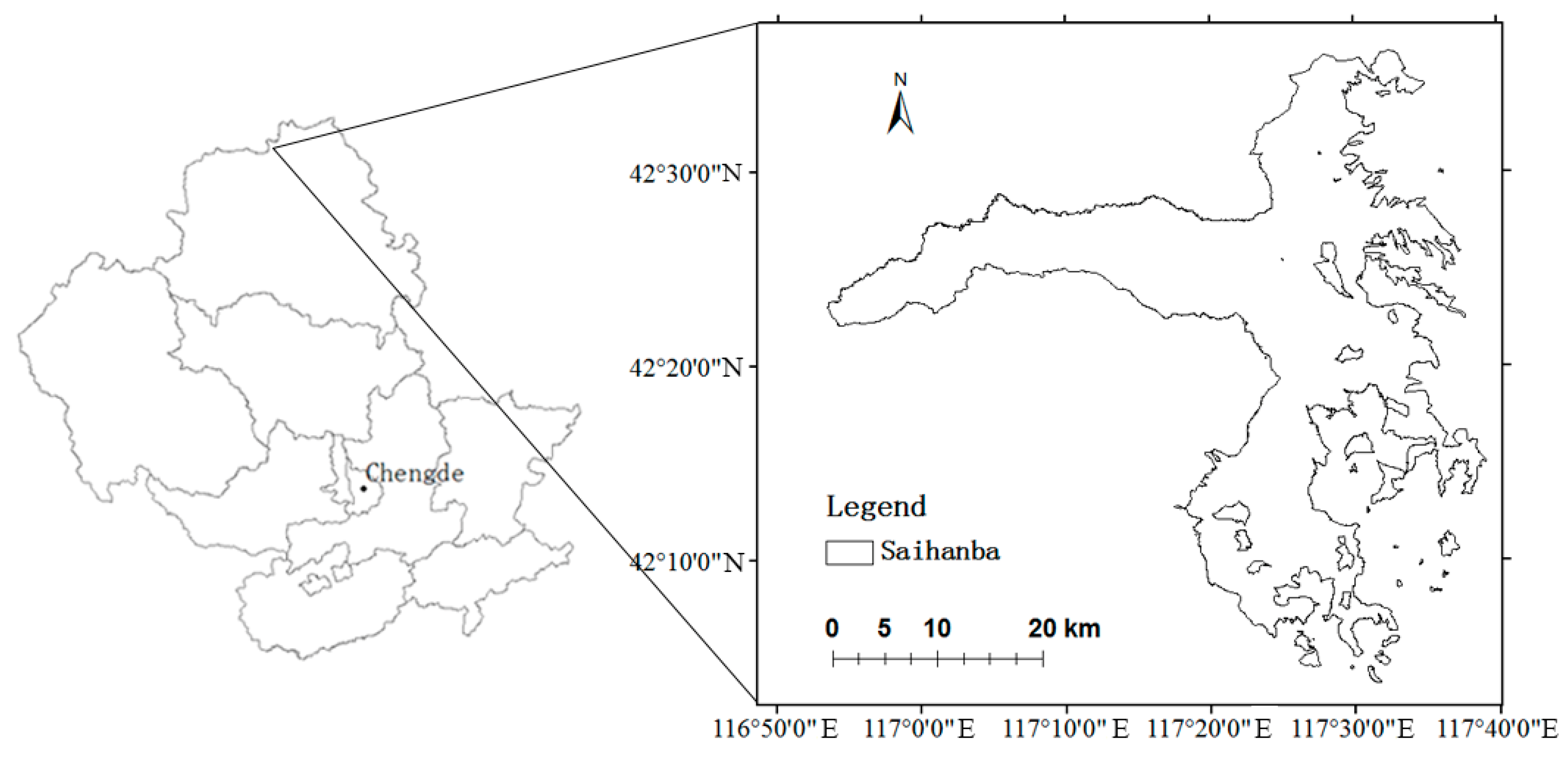
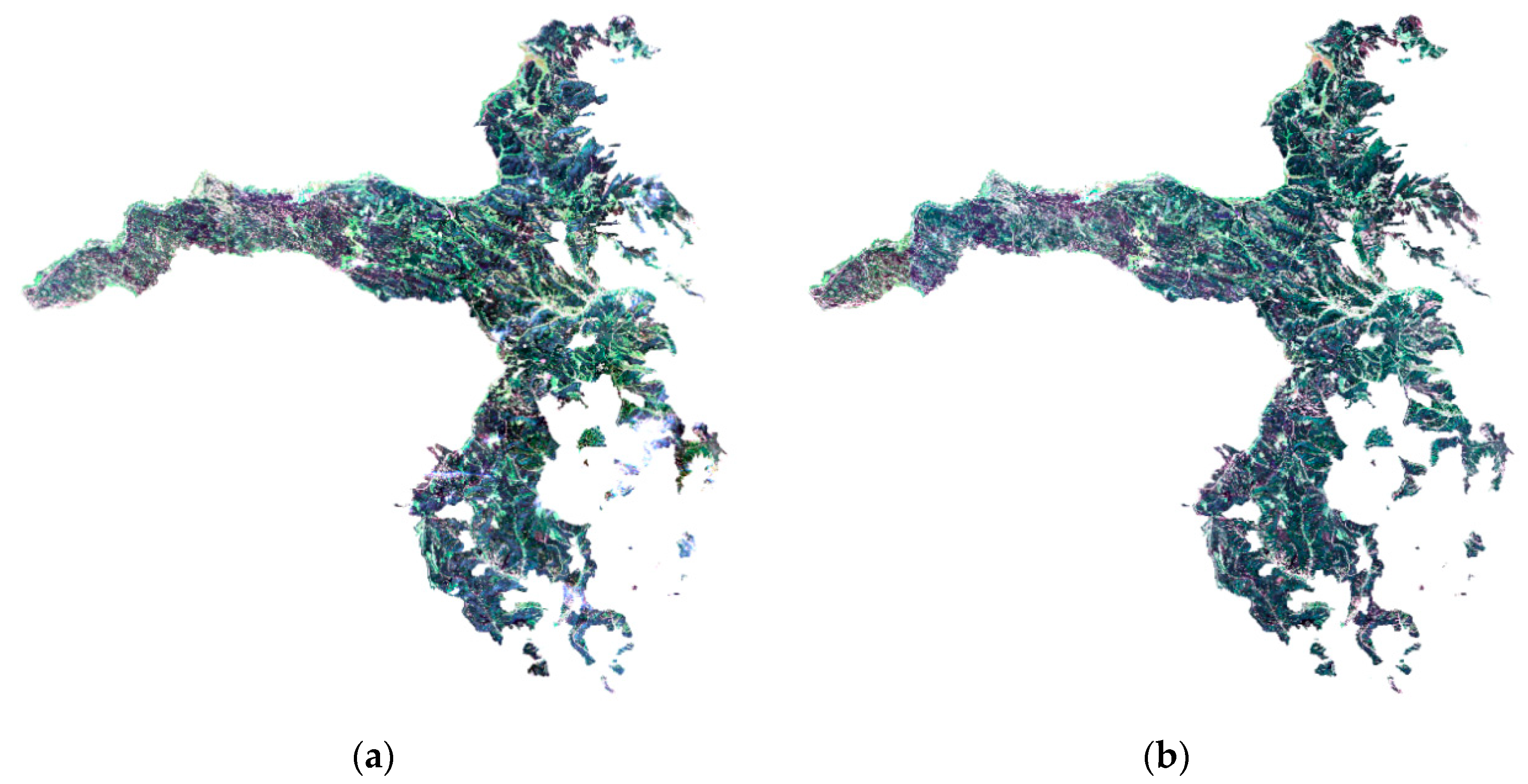

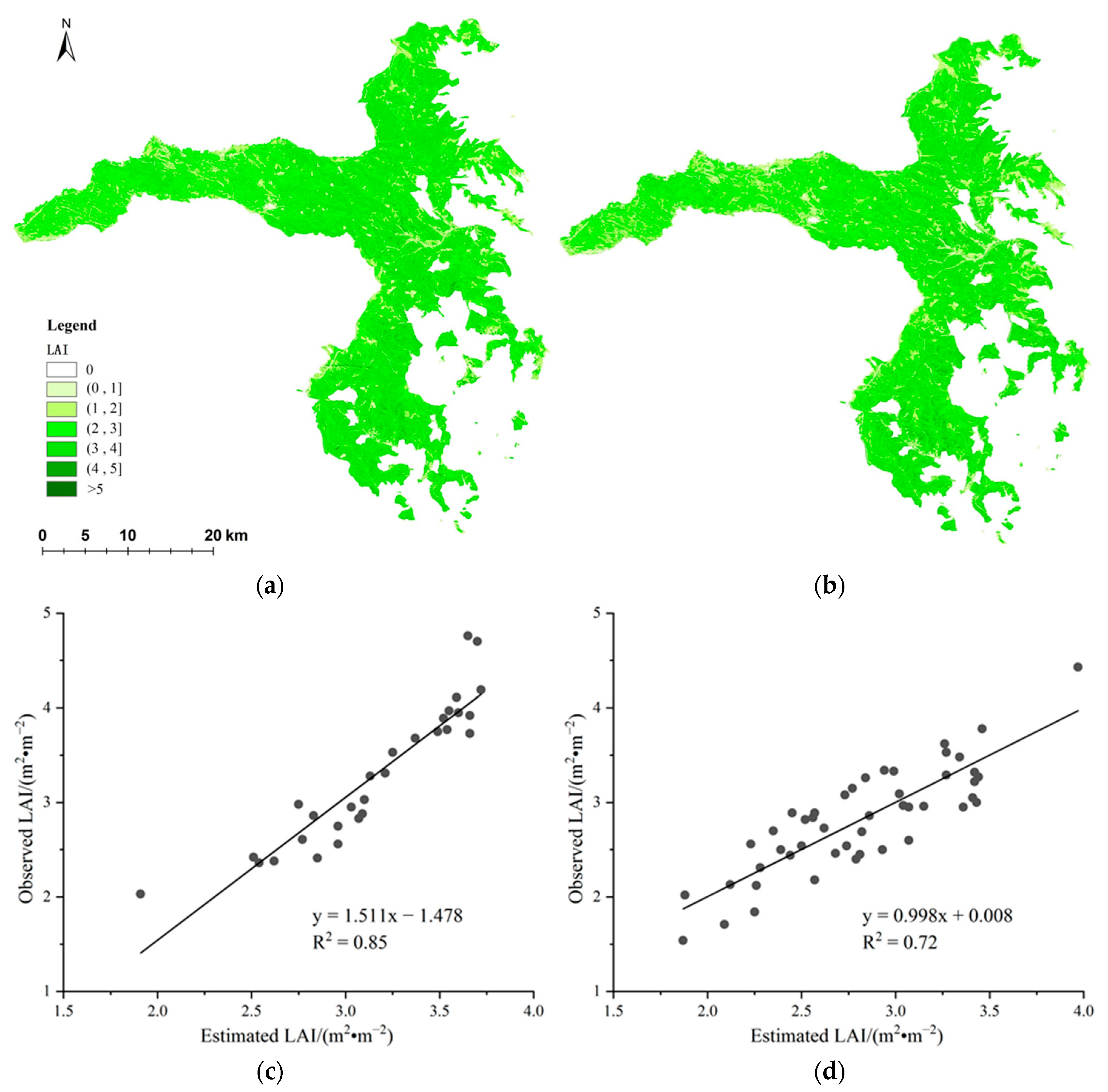
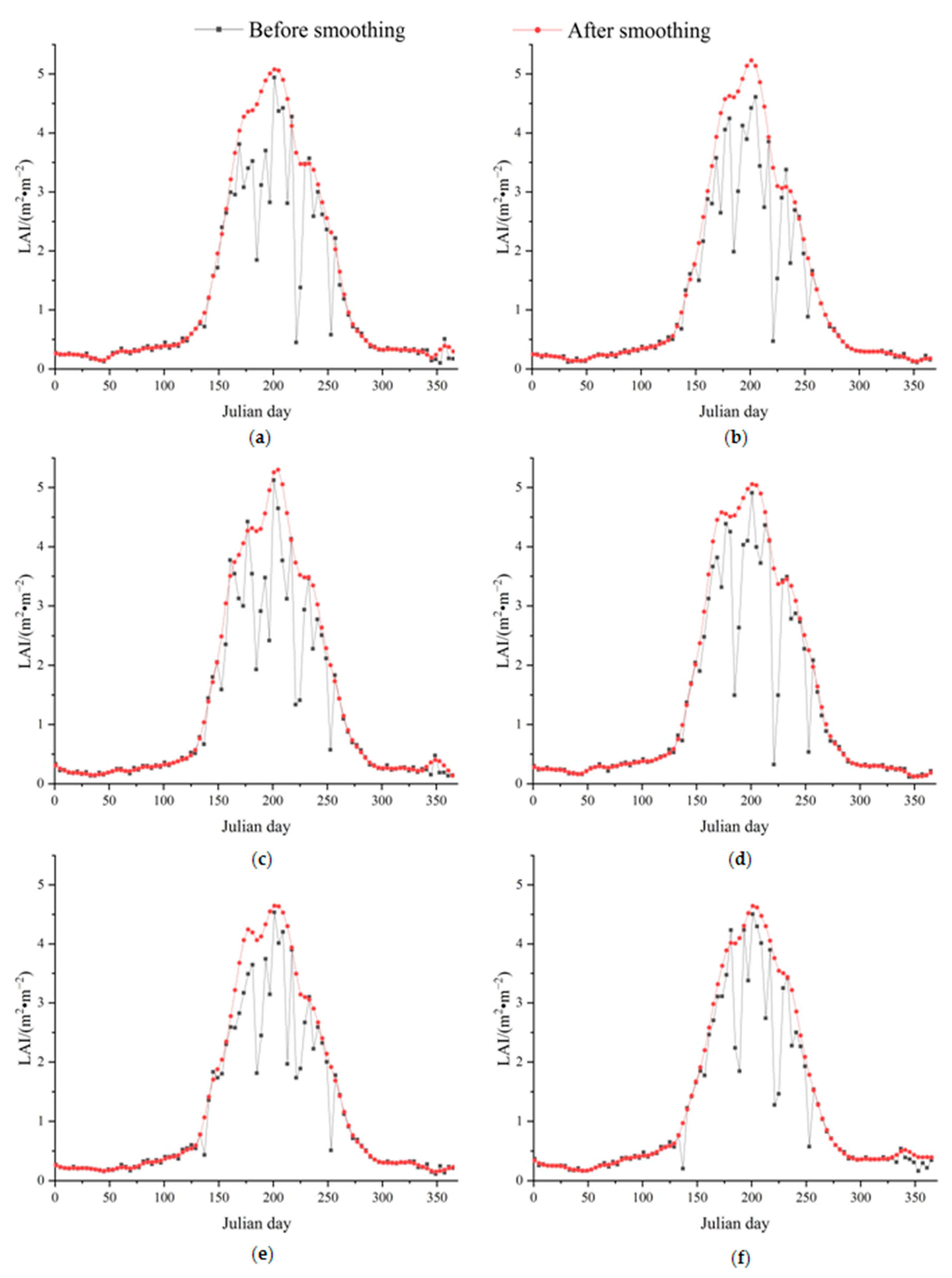


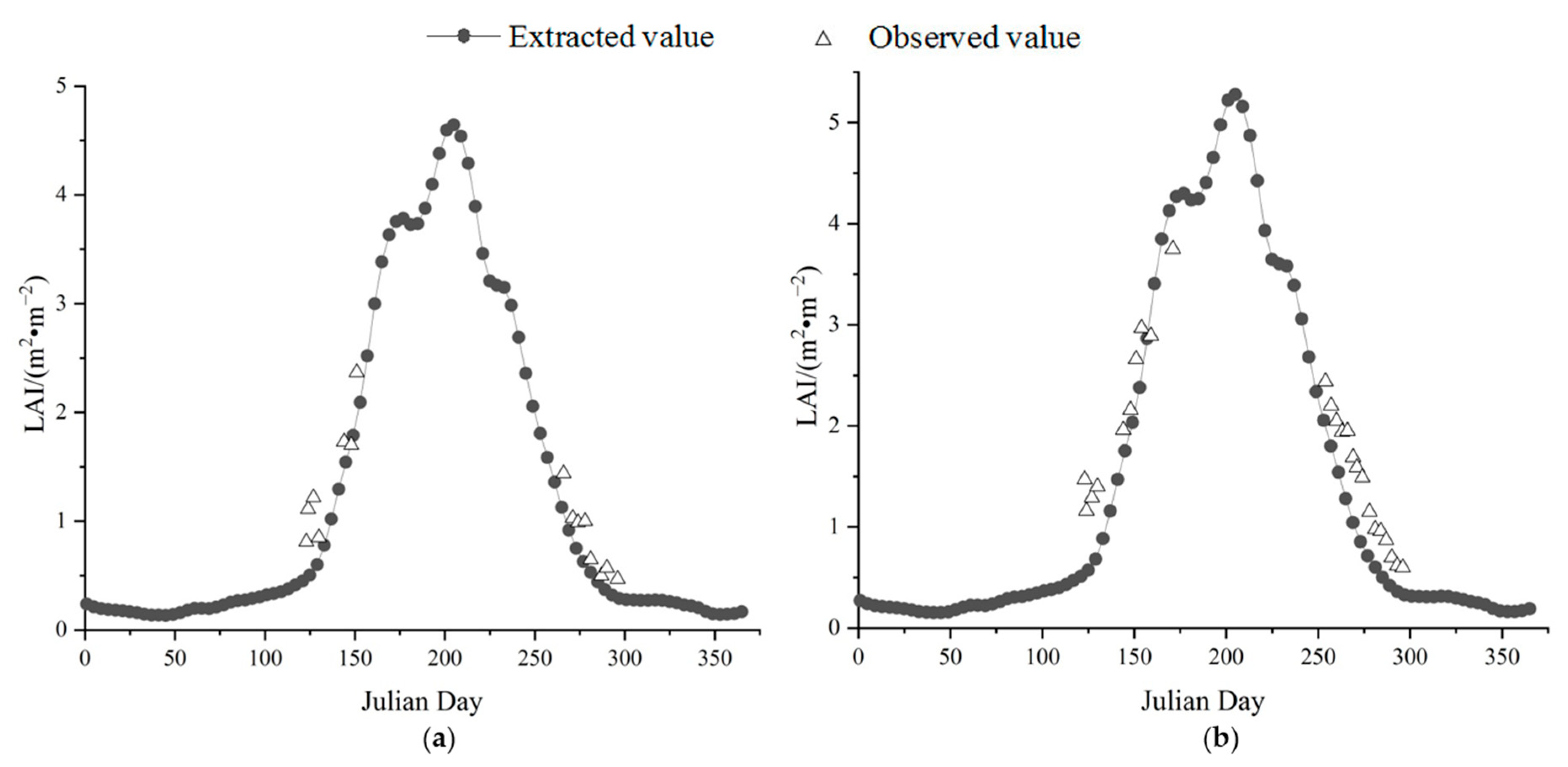
| Sample Plot | Coordinates |
|---|---|
| Ⅰ | 117.3185° N, 42.40883° E |
| Ⅱ | 117.2736° N, 42.44807° E |
| Ⅲ | 117.2676° N, 42.44339° E |
| Ⅳ | 117.2674° N, 42.44396° E |
| Vegetation Index | Formulation |
|---|---|
| NDVI | (NIR − R)/(NIR + R) |
| SR | NIR/R |
| DVI | NIR − R |
| ARVI | (NIR − RB)/(NIR + RB), RB = NIR − γ(B − R) |
| VI | Equation Type | Regression Equation | RMSE | |
|---|---|---|---|---|
| NDVI | Linear | LAI = 12.786NDVI − 7.48 | 0.392 | 0.457 |
| Quadratic | LAI + 53.13NDVI − 23.933 | 0.393 | 0.454 | |
| Logarithm | LAI = 10.422In NDVI + 4.093 | 0.393 | 0.454 | |
| Power | LAI | 0.423 | 0.443 | |
| Exponential | LAI = 0.071exp(4.662NDVI) | 0.42 | 0.444 | |
| Linear | LAI = 0.198SR + 0.964 | 0.374 | 0.463 | |
| Quadratic | LAI.448SR − 0.356 | 0.381 | 0.459 | |
| SR | Logarithm | LAI = 2.068In SR + 0.865 | 0.385 | 0.457 |
| Power | LAI | 0.401 | 0.451 | |
| Exponential | LAI = 1.438exp(0.066SR) | 0.375 | 0.461 | |
| Linear | LAI = 0.001DVI + 0.825 | 0.198 | 0.525 | |
| Quadratic | LAI .002DVI + 0.151 | 0.208 | 0.519 | |
| DVI | Logarithm | LAI = 1.375In DVI − 1.48 | 0.207 | 0.519 |
| Power | LAI | 0.186 | 0.526 | |
| Exponential | LAI = 1.953exp(0.002DVI) | 0.178 | 0.529 | |
| Linear | LAI = 10.729ARVI − 5.992 | 0.429 | 0.443 | |
| Quadratic | LAI4.381ARVI − 7.479 | 0.43 | 0.44 | |
| ARVI | Logarithm | LAI = 8.777In ARVI + 4.509 | 0.429 | 0.441 |
| Power | LAI | 0.499 | 0.413 | |
| Exponential | LAI = 0.102exp(4.043ARVI) | 0.493 | 0.415 |
| VIs Combinations | Regression Equation | RMSE | |
|---|---|---|---|
| NDVI, SR | LAI = 13.716NDVI − 0.014SR − 8.075 | 0.519 | 0.403 |
| NDVI, DVI | LAI = 13.688NDVI − 0.000074DVI − 8.056 | 0.521 | 0.402 |
| NDVI, ARVI | LAI = 11.228ARVI − 0.664NDVI − 5.859 | 0.528 | 0.399 |
| SR, DVI | LAI = 0.221SR + 0.00001DVI + 0.544 | 0.512 | 0.406 |
| SR, ARVI | LAI = 0.026SR + 9.435ARVI − 5.188 | 0.531 | 0.398 |
| DVI, ARVI | LAI = 10.175ARVI + 0.000069DVI − 5.672 | 0.532 | 0.397 |
| NDVI, SR, DVI | LAI = 12.058NDVI + 0.03SR − 0.000097DVI − 6.981 | 0.533 | 0.395 |
| NDVI, SR, ARVI | LAI = 15.109ARVI + 0.205SR − 18.42NDVI + 3.268 | 0.545 | 0.39 |
| SR, DVI, ARVI | LAI = 9.832ARVI + 0.000052DVI + 0.011SR − 5.461 | 0.533 | 0.395 |
| NDVI, DVI, ARVI | LAI = −4.713NDVI + 13.201ARVI + 0.00019DVI − 4.496 | 0.539 | 0.392 |
| NDVI, SR, DVI, ARVI | LAI = −18.322NDVI + 0.192SR + 0.000043DVI + 15.445ARVI + 2.95 | 0.561 | 0.381 |
| Principal Component | Characteristic Value | Variance Contribution/% | Cumulative Contribution/% |
|---|---|---|---|
| 3.523 | 88.075 | 88.075 | |
| 0.411 | 10.275 | 98.35 | |
| 0.057 | 1.425 | 99.775 | |
| 0.009 | 0.225 | 100.000 |
Disclaimer/Publisher’s Note: The statements, opinions and data contained in all publications are solely those of the individual author(s) and contributor(s) and not of MDPI and/or the editor(s). MDPI and/or the editor(s) disclaim responsibility for any injury to people or property resulting from any ideas, methods, instructions or products referred to in the content. |
© 2023 by the authors. Licensee MDPI, Basel, Switzerland. This article is an open access article distributed under the terms and conditions of the Creative Commons Attribution (CC BY) license (https://creativecommons.org/licenses/by/4.0/).
Share and Cite
Yang, Z.; Huang, X.; Qing, Y.; Li, H.; Hong, L.; Lu, W. Estimation of Time-Series Forest Leaf Area Index (LAI) Based on Sentinel-2 and MODIS. Appl. Sci. 2023, 13, 8777. https://doi.org/10.3390/app13158777
Yang Z, Huang X, Qing Y, Li H, Hong L, Lu W. Estimation of Time-Series Forest Leaf Area Index (LAI) Based on Sentinel-2 and MODIS. Applied Sciences. 2023; 13(15):8777. https://doi.org/10.3390/app13158777
Chicago/Turabian StyleYang, Zhu, Xuanrui Huang, Yunxian Qing, Hongqian Li, Libin Hong, and Wei Lu. 2023. "Estimation of Time-Series Forest Leaf Area Index (LAI) Based on Sentinel-2 and MODIS" Applied Sciences 13, no. 15: 8777. https://doi.org/10.3390/app13158777




